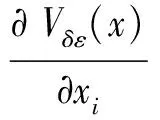Convergence Rate of Numerical Solutions for Nonlinear Stochastic Pantograph Equations
2013-12-22,
,
(College of Mathematics and Statistics,South-Central University for Nationalities,Wuhan 430074,China)
1 Introduction
The numerical solutions and stability of stochastic differential equations have been studied. The conditions of the existence and uniqueness of the analytical solutions for stochastic differential equations are usual local Lipschitz condition and linear growth condition[1]. The study for stochastic pantograph equations has just begun. Appleby and Buckwar give sufficient conditions for solutions of the linear stochastic pantograph equation to grow at a polynomial rate onpth mean and in the almost sure sense[2]. Baker and Buckwar study the numerical solutions of the linear stochastic pantograph equations and prove that the numerical solutions produced by the continuousθ-method converges to the true solutions with order 1/2[3]. In [4,5],The existence and uniqueness of the solutions and the convergence of semi-implicit Euler methods for stochastic pantograph equations (with Markovian switching)are considered,and convergence rate of the semi-implicit Euler methods is proved. Theαth moment stability for the stochastic pantograph equation is also given[6]. But in these paper,the conditions of stochastic pantograph equations satisfy local Lipschitz condition and linear growth condition.
In[7],Gyöngy and Rásonyi reveal the convergence rate of Euler approximations for stochastic differential equations whose diffusion coefficient is not Lipschitz but only (1/2+α)-Hölder continuous for someα>0 by using the Yamada and Watanabe′s method[8]. Wu,Mao and Chen prove the existence of the nonnegative solutions and the strong convergence of the Euler-Maruyama scheme for the Cox-Ingersoll-model with delay whose diffusion coefficient is nonlinear and non-Lipschitz continuous[9].

2 Existence and uniqueness of the analytical solution
Let (Ω,F,P)be a complete probability space with a filtration {Ft}t≥0satisfying the usual conditions. LetW(t)be anm-dimensional Brownian motion defined on the probability space adapted to the filtration. For integern>0,let (n,〈·,·〉,|·|)be the Euclidean space and ‖A‖:=the Hilbert-Schmidt norm for a matrixA,whereA*is its transpose. Throughout this paper,C>0 denotes a generic constant whose values may change from lines to lines.
Consider the stochastic pantograph equation onn
dX(t)=b(X(t),X(qt))dt+σ(X(t),
X(qt))dW(t),t∈[t0,T],
(1)


and

such that each stepsize 0<Δi<1,i=1,…,n.
By the definition of stochastic differential,fort∈[t0,T] ,this equation is equivalent to the following stochastic integral equation:


(2)
To guarantee the existence and uniqueness of the solutions we introduce the following conditions:
(A1)b:n×n→nand there existsL1>0 such that
|b(x1,y1)-b(x2,y2)|≤L1|x1-x2|+V1(y1,y2)·
|y1-y2|,forxi,yi∈n,i=1,2;
(A2)σ:n×n→n×mand there existsL2>0 such that
‖σ(x1,y1)-σ(x2,y2)‖≤L2|x1-x2|+
V2(y1,y2)|y1-y2|,forxi,yi∈n,i=1,2;
WhereVi:n×n→+such that
Vi(x,y)≤Ki(1+|x|qi+|y|qi),i=1,2,
(3)
for someKi>0,qi≥1 and arbitraryx,y∈n.
Obviously,ifbandσare globally Lipschitzian,they must satisfy the conditions of (A1),(A2). On the other hand,in many examples,bandσdon′t satisfy the Lipschitz condition and the linear growth condition but can be covered by (A1),(A2). Firstly,we investigate the existence and uniqueness of the solutions of (1).


(4)
ProofDue to the fact that bothbandσare locally Lipschitz,we can know that Eq.(1)has a unique local solution[1]. In order to verify that the solution is a unique global solution on time interval [t0,T] ,it is sufficient to show that
Calculate from (A1),(A2)and (3),we can obtain
|b(x,y)|≤C(1+|x|+|y|+|y|q1+1),x,y∈n,
(5)
and
‖σ(x,y)‖≤C(1+|x|+|y|+|y|q2+1),x,y∈n.
(6)
Substituting (5)and (6),the Hölder inequality and the Burkhold-Davis-Gundy inequality into (2),we have that for anyp≥2 andt∈[t0,T]





Letβ:=(q1+1)∨(q2+1),then

Together with the Gronwall inequality we get

(7)
Let

where [a] denotes the integer part of real numbera,thus,forβ≥1 andp≥2,we have


In the similar way,combining (7)with the Hölder inequality,further leads to


And

Repeating the previous procedures we then get (4). So the existence and uniqueness have been proved.
RemarkTheorem 1 gives a new result on existence and uniqueness of solutions to the nonlinear stochastic pantograph equations on finite-time interval. Under the conditions (A1)and (A2),there is a unique global solution for the nonlinear stochastic pantograph equations whose coefficients may be polynomial of any degreed≥1 ,that don′t satisfy the usual Lipschitz condition and the linear growth condition.
3 Convergence rate of Euler-Maruyama scheme
In this section we consider the Euler-Maruyama based computational method for Eq.(1)


(8)



By using the method of Theorem 1,we also have

(9)
Lemma1 Assume that (A1)and (A2)hold. Then,fort∈[t0,T]
(10)

ProofFor anyt∈[t0,T],there existsi,such thatt∈[ki,ki+1),then according to (8)we have:


Noting that

Using the Hölder inequality(see [1,Theorem 1.7.1]),(5)and (6),we then obtain that:



Now we can give the main convergence result.
Theorem2 Under (A1)and (A2),for anyp≥2 there exitsC>0 such that



Define

Thenφδε∈C2(+;+)have the following properties:
x-ε≤φδε(x)≤x,x>0,
(11)
and
(12)
Define
Vδε(x):=φδε(|x|),x∈n.
(13)
By the definition ofφδε,it is trivial to note thatVδε∈C2(n;+). For anyx∈nset

And by computation,we get

0≤|(Vδε)x(x)|≤1 and ‖(Vδε)xx(x)‖≤

(14)
For anyt∈[t0,T],let


Vδε(Z(t))=




By (14),(A1)and the Hölder inequality,we deduce that:



(15)
and due to (14),(A2)and the Hölder inequality again we have:





t∈[t0,T].
(16)
Together with the Burkhold-Davis-Gundy inequality,the Hölder inequality




t∈[t0,T],
(17)
Moreover,by virtue of (3),(4)and (9)that


Furthermore,together with the Gronwall inequality that

(18)
For anyp≥2 ,let

Thus,due top≥2 ,it is not very difficult to see thatpi≥2 such that

(19)

This,together with (19)and the Hölder inequality,further gives that
Repeating the previous procedures,then the proof is complete.
The strong convergence of Euler-Maruyama scheme for stochastic pantograph equations was generally investigated under Lipschitz condition and bounded moments of analytic solutions and numerical solutions,or Lipschitz condition and linear growth condition. In this paper,under more general conditions,we not only show the strong convergence but also reveal the convergence order for a class of stochastic pantograph equations,where the coefficients may be highly nonlinear.
[1] Mao X. Stochastic differential equations and applications [M]. Chichester:Horwood Pub Ltd,2007.
[2] Appleby J A D,Buckwar E. Sufficient conditions for polynomial asymptotic behavior of the stochastic pantograph equation [EB/OL]. [2003-11-18].http://www.dcu.ie/maths/research/preprint.shtml.
[3] Baker C T H,Buckwar E. Continuousθ-methods for the stochastic pantograph equation[J]. Electron Trans Numer Anal,2000,11: 131-151.
[4] Fan Z,Liu M ,Cao W. Existence and uniqueness of the solutions and convergence of semi-implicit Euler methods for stochastic pantograph equations[J]. J Math Anal Appl,2007,325: 1142-1159.
[5] Li R,Liu M. Convergence of numerical solutions to stochastic pantograph equations with Markovian switching[J]. Applied Mathematics and Computation,2009,215: 414-422.
[6] Fan Z,Song M. Theαth moment stability for the stochastic pantograph equation[J]. J Comput Appl Math,2009,233: 109-120.
[7] Gyöngy I,Rásonyi M. A note on Euler approximations for SDEs with Hölder continuous diffusion coefficients[J]. Stochastic Process Appl,2011,121: 2189-2200.
[8] Yamada T,Watanabe S. On the uniqueness of solutions of stochastic differential equations[J]. J Math Kyoto Univ,1979,11: 155-157.
[9] Wu F,Mao X,Chen K. The Cox-Ingersoll-model with delay and strong convergence of its Euler-Maruyama approximate solutions[J]. Applied Numerical Mathematics,2009,59: 2641-2658.
